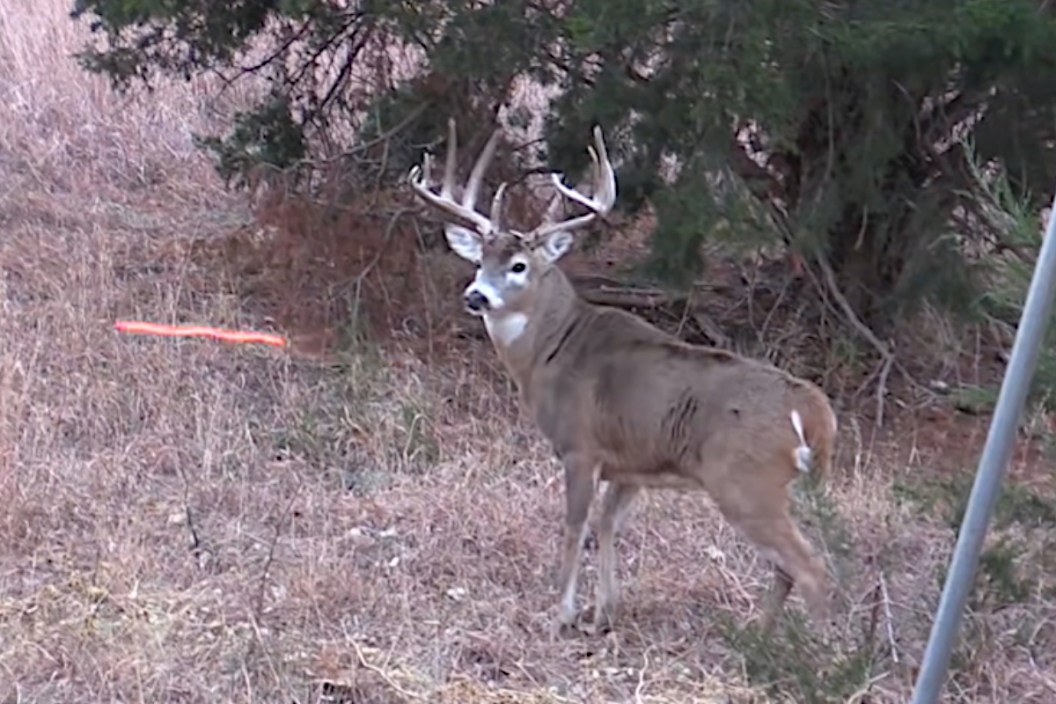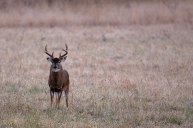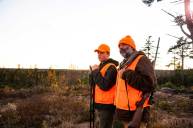Should we show kill shots on video?
In the modern age of hunting, it seems like everyone is filming their hunts. What started as something only a select few pros would do has morphed into an industry all its own. In the early days, companies like Realtree and Mossy Oak cemented their name by selling VHS tapes of their pro staff's quests for big bucks.
With the Internet, the phenomenon of capturing a hunt on video only grew larger. Now thousands of hunters take to the woods with their cameras every season in hopes of not only putting some meat in the freezer, but also in hopes of capturing their adventure on camera for the world to see.
This brings up an interesting question. Should we show the exact moment our bullet, arrow, or the pellets from a shotgun shell impact and take an animal's life? I know some of you are immediately going to say: "That's stupid," or "why shouldn't we?" Well, before you send an angry email calling me dumb or a "snowflake," hear me out. Because I'm torn on the issue. There are some interesting ethical questions to ask about this subject and I'm not sure there are any clear answers.
The history of filming hunts.
Many hunters may think the practice of filming hunts is a recent one, but they'd be wrong. Because bowhunting legends were doing it long before anyone else. Legendary bowhunter Arthur Young is usually credited with making the first bowhunting movie, Alaskan Adventures, all the way back in 1923. Many of his videos are now online where a whole new generation of hunters can experience them. He wasn't alone in being an early pioneer of filming hunts either. Guys like Fred Bear and Jim Dougherty also filmed their wilderness adventures, never really shying away from showing the kill shot.
However, it was not until the rise of VHS tapes and the whole direct-to-video industry that hunting videos really started to take off. In the late 80s and early 90s, new stars in the hunting world like Roger Raglin, Bill Jordan, and Michael Waddell emerged. I'll never forget watching Knight & Hale's Ultimate Whitetail Season on VHS back in 1995. It was the first, but not last hunting video I ever saw.
It's safe to say plenty of other people saw and were inspired by the 90s boom in hunting videos too because now the Internet is full of regular sportsmen and women without big name sponsors behind them trying to make a name for themselves in the outdoors industry. While one can argue it was guys like Art Young who started the whole thing, I truly believe it was those early 80s and 90s VHS hunters who helped build the foundation of the outdoor show industry as it exists today. Most of the hunting shows we watch now likely would have never happened if not for the success of those early video pioneers.
In defense of showing kill shots.
Going back to my experience watching that early Knight & Hale video back in 1995, the biggest plus side to showing kill shots is the educational aspect. I was 11 years old at the time and prior to that video had never seen a deer being shot before. Michigan's youth deer seasons were still more than a decade away from being established, so I only had stories to go on to know how deer reacted after being shot. I knew that no two were the same. I knew some deer might drop in their tracks and I knew some might run and need tracking. However, prior to watching the guys on that video arrow and shoot more than a dozen bucks with rifles, I had no idea what happens when you shoot a deer.
I'm thankful those videos did exist. Because without them, I might not have known how to judge if my first shot at a whitetail was a good one or not. From those videos I learned a high kick was indicative of a heart shot, and that deer usually run with their tail down after being hit. I shot my first buck six years after watching that first video, and because I had watched so many hunting videos, I was able to judge the quality of my shot myself.
For me, that's the biggest redeeming factor of showing a kill shot in a hunting video. The educational aspect. It helps prepare newer hunters for exactly what they can expect without venturing into the field. Watching these videos can also help people who on the fence about hunting decide if they can stomach the reality of hunting. Let's face it, it's not for everyone. Some people cannot handle taking the life of an animal. I don't know about you, but I'd rather they decide that from a video than after they've already shot a deer.
Another reason to keep kill shots in these videos is simply because that is the reality of hunting. If we try to hide what the kill shot does to an animal, you could argue we are not painting a complete picture of what a hunt is truly like to an outsider. Showing the kill shot illustrates we are fully aware of what our weapon is doing to the animal. It shows we know exactly where our food is coming from. To cover up those vital few seconds of the hunt feels like we are trying to hide the reality of that aspect of the hunt. And the last thing we want is to not be genuine about any aspect of this tradition.
I would even argue it's worth showing bad shots. Because no matter how much you practice, no matter how patient you are, sometimes things happen. The deer ducks the arrow, an unseen branch deflects your shot. Maybe you simply guessed wrong on the yardage. Showing these mistakes, and how the animal reacts to them can help guide other hunters on what to do when they are faced with a similar situation. And if you hunt long enough, we can guarantee you will face one. Any hunter who says they have not is lying to you.
In defense of editing the kill shot out.
While I think there are many valid reasons for keeping the kill shot in a hunting video, I have also seen and heard plenty of valid reasons to edit out that part of the hunt. Last year I interviewed country music star Lucas Hoge about his new outdoor show on the Sportsman Channel called "Hoge Wild." During our discussion, he told me they were not planning on putting a lot of kill shots on video despite it being a hunting show. However, he brought up a good point about the mainstream media skewing what hunting is all about. He said his goal was to change the narrative of hunting.
"A lot of those people don't understand what we do, they think we are just out there slaughtering animals," Hoge said.
He's not wrong about that. Just taking a moment to think about what the hunting industry must look like from the outside looking in, it's easy to see how people can get that impression. Just search up "bowhunting kills" on YouTube and you'll be hit with dozens of fast compilations of arrows striking a whole plethora of animals with no other context to the hunt wrapped around them. I'm not saying this type of compilation is wrong, but it's easy to see how a stranger to hunting will get the wrong impression of us from seeing that. Because it may look to some that we only enjoy the act of killing the animal, which is not true, but how is someone who's never stepped in the woods before to know that?
For me, it's easy to understand why shows like Steven Rinella's "Meateater" have gained mainstream appeal while other shows have not. Rinella shows kill shots on his show, but he also shows the dressing, skinning, and cooking of the animal at the end. It's amazing how he makes even some vegans understand what hunting is about when you put everything in the proper context.
One could easily argue that shows that cut the feed after they find and admire the antlers of that big buck may be doing more harm than good in the end. Because everyone can relate to wanting to know exactly where their food is coming from. Not everyone can relate to being excited about taking a buck simply because it's the largest you've ever killed.
Another problem with kill shots is unique to the Internet age and that's sites like YouTube coming up with rules specifically banning the showing of kill shots in hunting. The thing that is worrying here are the full-time outdoor influencers on these sites who depend on ad revenue to make a living. Many of these men and women have spent years building up their following through a lot of hard work only for it to be yanked away because a Google policy change says their videos are not appropriate anymore. I cannot begin to imagine how frustrating and scary it must be to have your revenue cut off because of a moment that literally takes up less than a second of time in your videos. I've noticed an increasing trend of hunting YouTubers cutting out the kill shots completely just because they are scared they won't be able to pay the bills next month because their channel may be demonetized. If I was starting a serious hunting channel now, I'd probably be proactive and cut those shots out just to be on the safe side. Because until an alternative that won't punish creators for showing the reality of hunting comes along, we are forced to play by their rules. I don't like it any more than the next guy.
The matter merits further discussion.
I've been writing a lot about the issues facing hunting these days the last few months. Because times are changing fast and hunting as a tradition is in peril of ceasing to exist one day. Mostly from a failure to change with the times. And a loss of hunting is a loss for conservation from the income generated from the sales of licenses, rifles, and other hunting equipment. Without those funds, the beautiful, wild areas of the outdoors we all love could potentially be in peril.
I firmly believe it's worth putting a microscope on almost every facet of hunting. If for no other reason than to figure out where we might be alienating a segment of potential new hunters. At the very least it's worth a discussion with all the people who regularly film hunts to figure out the best strategy going forward. Whether that includes continuing to show kill shots in hunting videos is up for debate.
Because there are serious merits to both sides of this argument, it's hard for me to say where my opinion falls on the matter. At the very least I hope it spurs conversation with all shareholders who are regularly involved in the filming of hunts.
Products featured on Wide Open Spaces are independently selected by our editors. However, when you buy something through our links, we may earn a commission.
For more outdoor content from Travis Smola, be sure to follow him on Twitter and check out his Geocaching and Outdoors with Travis YouTube channels.
NEXT: THE AXIS DEER AND HOW THEY'RE IMPACTING PARTS OF THE UNITED STATES
WATCH





